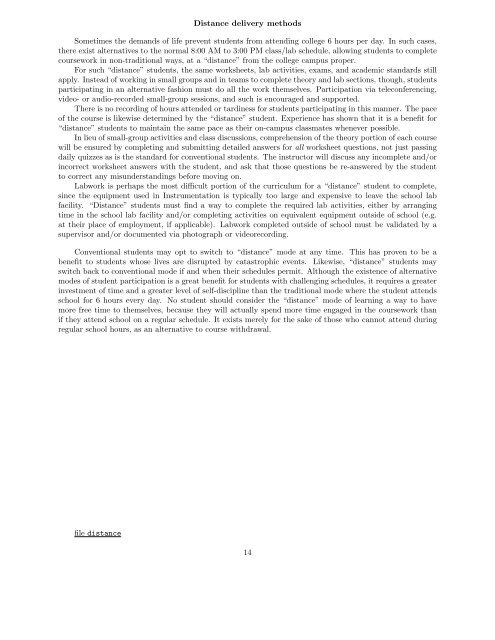INST 262 (DCS and Fieldbus), section 2 Lab Automatically ...
INST 262 (DCS and Fieldbus), section 2 Lab Automatically ...
INST 262 (DCS and Fieldbus), section 2 Lab Automatically ...
Create successful ePaper yourself
Turn your PDF publications into a flip-book with our unique Google optimized e-Paper software.
Distance delivery methods<br />
Sometimes the dem<strong>and</strong>s of life prevent students from attending college 6 hours per day. In such cases,<br />
there exist alternatives to the normal 8:00 AM to 3:00 PM class/lab schedule, allowing students to complete<br />
coursework in non-traditional ways, at a “distance” from the college campus proper.<br />
For such “distance” students, the same worksheets, lab activities, exams, <strong>and</strong> academic st<strong>and</strong>ards still<br />
apply. Instead of working in small groups <strong>and</strong> in teams to complete theory <strong>and</strong> lab <strong>section</strong>s, though, students<br />
participating in an alternative fashion must do all the work themselves. Participation via teleconferencing,<br />
video- or audio-recorded small-group sessions, <strong>and</strong> such is encouraged <strong>and</strong> supported.<br />
There is no recording of hours attended or tardiness for students participating in this manner. The pace<br />
of the course is likewise determined by the “distance” student. Experience has shown that it is a benefit for<br />
“distance” students to maintain the same pace as their on-campus classmates whenever possible.<br />
In lieu of small-group activities <strong>and</strong> class discussions, comprehension of the theory portion of each course<br />
will be ensured by completing <strong>and</strong> submitting detailed answers for all worksheet questions, not just passing<br />
daily quizzes as is the st<strong>and</strong>ard for conventional students. The instructor will discuss any incomplete <strong>and</strong>/or<br />
incorrect worksheet answers with the student, <strong>and</strong> ask that those questions be re-answered by the student<br />
to correct any misunderst<strong>and</strong>ings before moving on.<br />
<strong>Lab</strong>work is perhaps the most difficult portion of the curriculum for a “distance” student to complete,<br />
since the equipment used in Instrumentation is typically too large <strong>and</strong> expensive to leave the school lab<br />
facility. “Distance” students must find a way to complete the required lab activities, either by arranging<br />
time in the school lab facility <strong>and</strong>/or completing activities on equivalent equipment outside of school (e.g.<br />
at their place of employment, if applicable). <strong>Lab</strong>work completed outside of school must be validated by a<br />
supervisor <strong>and</strong>/or documented via photograph or videorecording.<br />
Conventional students may opt to switch to “distance” mode at any time. This has proven to be a<br />
benefit to students whose lives are disrupted by catastrophic events. Likewise, “distance” students may<br />
switch back to conventional mode if <strong>and</strong> when their schedules permit. Although the existence of alternative<br />
modes of student participation is a great benefit for students with challenging schedules, it requires a greater<br />
investment of time <strong>and</strong> a greater level of self-discipline than the traditional mode where the student attends<br />
school for 6 hours every day. No student should consider the “distance” mode of learning a way to have<br />
more free time to themselves, because they will actually spend more time engaged in the coursework than<br />
if they attend school on a regular schedule. It exists merely for the sake of those who cannot attend during<br />
regular school hours, as an alternative to course withdrawal.<br />
file distance<br />
14


